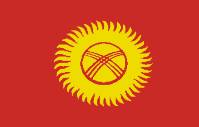Special Program for International Students
GRADUATE COURSE IN EARTH SCIENCE
& GEOENVIRONMENTAL SCIENCE
Current MEXT students
Rustam Orozbaev (Kyrgyzstan)
Email: s059707 @matsu.shimane-u.ac.jp,
rustamot76 @mail.ru
Thesis title: Tectonic processes of the Tien-Shan Mountains: petrology, geochemistry and geochronology of the eclogites, gneisses and ophiolites in the Aktyuz region, Zaily Range, Kyrgyzstan.
Supervisor: Prof. Akira Takasu (2005-2008).
The objects of my doctoral research are the Kemin Series and the Aktyuz HP metamorphic rocks. These units represent the Precambrian basal fragments in the Zaily Range of the Northern Tien-Shan, and form one of the ancient formations in the Tien-Shan, Kyrgyzstan. All are located within the Aktyuz region.
The Kemin Series includes the Kopurelisay Formation, Kapchygai Formation and Kokbulak Formation. The Kopurelisay Formation are composed of deformed metagabbros, metabasalts, meta-ultrabasites, and intercalated metasediments, and are one of the oldest ophiolite formation in the Tien-Shan. The ophiolites are completely bordered by faults. Primary structures are preserved in gabbros and basalts in the central parts of the large bodies. Peridotites are completely altered to serpentinites. The Kapchygai Formation is characterized by basic migmatites, consisting of amphibolites, metagabbros, eclogites, serpentinites, talc schists and plagiogneisses. The Kokbulak Formation is pelitic in nature and contains carbonaceous migmatites represented by graphite gneisses, quartz schists and graphite-bearing marbles.
In the Aktyuz Formation the eclogites, garnet amphibolites and amphibolites occur as lenses and layers in pelitic gneisses and gneissose granites. There are three different metamorphic events in the Aktyuz eclogites, i.e. the low-P/T metamorphism of the metamorphic soles beneath ophiolites at the inception of subduction zone metamorphism, the high-P/T metamorphism in the subduction zone and low P/T metamorphism which also affected the country rock gneisses. The P-T path of the prograde metamorphism during the second event of the metamorphism is clockwise from the epidote-blueschist facies to the eclogite facies (P>16 kbar, T=685ºC).
The geologic relationship between the Aktyuz Formation and the Kopurelisay ophiolites is still under discussion, as metamorphism grade in the former is apparently higher than in the latter. There are no petrological studies on the Kemin Series metamorphic rocks so far.
The geochemistry of this region is poorly studied. On the basis of several previous studies the Aktyuz region is considered to be of Archean-Proterozoic age, but this is not yet properly established.
The main objectives in my doctoral research are:
- Petrological study of the Kemin Series metamorphic rocks, in order to determine the P-T conditions and the metamorphic evolution of these formations, based on detailed petrographic description and chemical analyses of constituent minerals.
- Geochemical study of trace elements and REE of metabasites from the Kemin Series and the Aktyuz Formation to determine the protolith of the metamorphic rocks;
- Geochronological study of the Aktyuz Formation and the Kemin Series to determine their metamorphic and protolith ages. We will determine Sm-Nd and Rb-Sr isotopic ages of the metamorphic rocks, and acquire protolith and metamorphic ages by monazite/zircon CHIME method;
- Geodynamic implications of the eclogites and their country rocks, and ophiolites in the Aktyuz region, to constrain the geodynamic model of the Precambrian mountain building history of the Tien-Shan.
This study will provide local important information about the geology of the area, which in turn contributes to a better understanding of geology of the Kyrgyz Tien-Shan. This study will also improve our understanding of the process of Tien-Shan mountain building during Caledonian-Hercynian movements, as related to typical subduction and subsequent collision tectonics.



